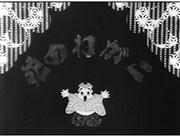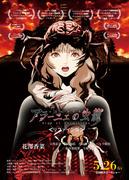"Golden Flower" Review: An anime that combines beauty and depth

Detailed review and recommendation of Golden Flower - Koganenohana -■ Public Mediatheater ■ Original MediaAnime Original ■ Release dateMay 1929 ■Frequencies7 mins ■ Number of EpisodesEpisode 1 ■ DirectorIllustration by Nobuo Ofuji ■ ProductionChiyogami Film Company ■ StoryLong ago, in the village of Tanoki, a Kagura performer named Dangobei lived a modest life with his mother. He was invited to a festival in a neighboring village, where he performed a Kagura dance. After receiving thanks, he hurried home at night. On the way, he took a wrong turn and ended up lost in the mountains. Suddenly, a giant snake appeared before Dangobei, and he was shocked. "I am Dangobei, born in Tanoki. Please spare my life," he said. The snake misheard and demanded, "I heard that tanuki (Tanoki) are seven-disguised creatures. Show me your transformation." Dangobei remembered that he had Kagura masks, so he put on Okame and Hyottoko masks and danced. The snake forgave Dangobei. Feeling relieved, he smoked a cigarette, and the snake said that he hated tobacco tar. The snake asked Dangobei what he hated most, and he answered that money scared him the most. Dangobei finally returns to the village and tells the story of the incident, and the villagers gather all the tar in the village and defeat the giant snake. The ghost of the giant snake then comes back to get revenge, throwing gold coins at Dangobei, and his house becomes filled with them. ■ExplanationIt was prototyped as a Cinecolor, record-talkie film, but the film that was shown to the general public was based on the rakugo story "Tanokyu," in which the Kagura performer Dangobei slays a giant snake and obtains gold. It is a masterpiece that combines the eerie depiction of Dangobei getting lost on a mountain path at night with the humor of tricking the giant snake. A black and white silent version. A chiyogami animation version of the rakugo story "Tanokyu." ■Detailed evaluation"Golden Flower" is a Japanese animated film released in 1929, and is highly valued for its historical and artistic merit. Director Ofuji Nobuo produced this film under the Chiyogami Eigasha company, and used the technology and art of the time to visualize a story based on the Rakugo story "Tanohisa." This film was prototyped as a Cinecolor film and a record talkie, but was shown to the public in black and white silent film. The story is about Dangobei, a Kagura performer living in the village of Tanoki, who performs a Kagura dance at a festival in a neighboring village and encounters a giant snake in the mountains on his way home. Dangobei begs the snake for his life and succeeds in tricking it using a Kagura mask. However, his feud with the snake continues, and in the end Dangobei's house is filled with gold coins. The story skillfully incorporates the essence of the rakugo story "Tanohisa," while making use of the expressive power unique to animation. The appeal of this film lies above all in the fusion of the humor in the scene where Dangobei tricks the giant snake and the eerie depiction of the mountain path at night. The scene where Dangobei dances wearing Okame and Hyottoko masks combines visual impact and humor, and has the power to draw the audience in. Additionally, the depiction of the mountain path at night, combined with the black-and-white images and the silence unique to silent films, effectively creates a sense of fear. The combination of these elements gives "Golden Flower" a unique atmosphere. There are also many noteworthy aspects of this work from a technical standpoint. The fact that it was prototyped as a Cinecolor film and a record talkie shows just how advanced Japanese animation technology was at the time. Cinecolor was not yet a common technology, so the fact that a prototype was made is particularly significant. Furthermore, the fact that it was prototyped as a record talkie shows that attempts to create animation with sound had already been made. It can be said that these technical attempts had a major impact on the later development of Japan's animation industry. "Golden Flower" is an outstanding work in terms of story, artistry and technique, and is an essential piece for understanding the Japanese animation culture of that time. In particular, the story, based on the rakugo story "Tanokyu," is significant in that it created a new form of expression that combined traditional Japanese performing arts with animation. In addition, the fact that it was released to the public as a black-and-white silent version allowed the visual expressiveness and the effect of silence to be maximized. The combination of these elements has made "Golden Flower" a masterpiece that will remain in the history of Japanese animation. ■Recommendation details"Golden Flower" is a film that is especially recommended for those who are interested in Japanese animation and rakugo. The story is based on the rakugo story "Tanokyu", and you can enjoy a new form of expression that combines traditional Japanese performing arts and animation. In addition, the fact that it was released to the public as a black and white silent version has maximized the visual expressiveness and the effect of silence, allowing you to feel the artistic quality of the film. Furthermore, this work has many noteworthy aspects from a technical standpoint. The fact that it was prototyped as a Cinecolor and record-talkie film shows how advanced Japanese animation technology was at the time, making it extremely interesting for anyone with an interest in animation history. Cinecolor was not yet a common technology, so the fact that a prototype was made is particularly significant. The fact that it was prototyped as a record-talkie film shows that attempts to create animation with sound had already been made, and it can be said that it had a major impact on the later development of Japan's animation industry. "Golden Flower" is an outstanding work in terms of story, artistry and technique, and is an essential piece for understanding the Japanese animation culture of that time. In particular, the story, based on the rakugo story "Tanokyu," is significant in that it created a new form of expression that combined traditional Japanese performing arts with animation. In addition, the fact that it was released to the public as a black-and-white silent version allowed the visual expressiveness and the effect of silence to be maximized. The combination of these elements has made "Golden Flower" a masterpiece that will remain in the history of Japanese animation. When watching this film, it would be a good idea to read the original Rakugo story "Tanokyu" beforehand to gain a deeper understanding of the background and intent of the story. Also, since there are few opportunities to watch black-and-white silent films these days, I would highly recommend watching it if you have the chance to see it at a cinema or online. In addition, there are prototype versions made as Cinecolor and record talkies, so it would be an interesting experience to look for materials on these versions. "Golden Flower" is an outstanding work in terms of story, artistry and technique, and is an essential piece for understanding the Japanese animation culture of that time. In particular, the story, based on the rakugo story "Tanokyu," is significant in that it created a new form of expression that combined traditional Japanese performing arts with animation. In addition, the fact that it was released to the public as a black-and-white silent version allowed the visual expressiveness and the effect of silence to be maximized. The combination of these elements has made "Golden Flower" a masterpiece that will remain in the history of Japanese animation. |
Recommend
Detailed review and recommended points of "Household Hygiene" anime
"Domestic Hygiene": The appeal of anima...
"Detective Conan: Halloween Bride" new cast Shiraishi Mai challenges voice acting for the first time
The 25th animated film in the series, "Detec...
Thor 5 will announce a new director at the San Diego Comic-Con
The Marvel movie "Thor 5" will be offic...
Impressions and reviews of the movie "Soreike! Anpanman: Ringoboya and Everyone's Wishes"
Deep dive into the appeal and emotion of the movi...
The first PV of "The Maid I Hired Recently Is a Little Strange" is confirmed to be broadcast on July 23
The TV animation of "My Recently Hired Maid ...
Famitsu News: The animation "Chainsaw Man" will be broadcast on October 11
According to the Famitsu newsletter ryokutya2089,...
The cruel game begins again. The second season of "Squid Game" released a fixed trailer
Netflix today released a new trailer for the seco...
The appeal and reviews of "Freezing Vibrations": A fusion of action and drama
Freezing Vibration - A story of deep bonds and ba...
The Story of Footwear and Umbrellas: Reevaluating the Emotion of Everyone's Song
The Story of Footwear and Umbrellas - Hakimonotok...
Blue Skies and Tap Dance: A Thorough Analysis of the Charm of Minna no Uta
Blue Sky and Tap Dance - Aozora Tap Dance overvie...
A thorough review of the adorable adventure of "Looking for the Full Moon"!
"Looking for the Full Moon: A Cute, Cute Adv...
The appeal and evaluation of Sound! Euphonium: Euphonium series TV #1
Sound! Euphonium: A tale of youthful melody and g...
The new visual image of the TV animation "Rent-a-Girlfriend" is released, and the four heroines appear!
According to the new news released by the officia...
The Witcher Season 2 will suspend filming for two weeks due to the epidemic
Update Message: The official has notified all sta...
The appeal and reviews of "Sword Art Online: Ordinal Scale": A thorough analysis of the new VR world adventure
"Sword Art Online: Ordinal Scale" - The...









